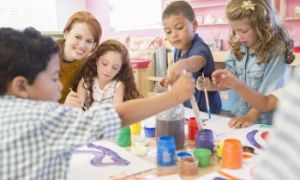Quality Area 3 has two standards that focus on the design of service facilities and the use of the service’s physical environment to support children’s experiences.
There are three Exceeding themes that services will need to demonstrate for a standard to be rated Exceeding NQS. A rating of Exceeding NQS means going above and beyond what is expected at the Meeting NQS level for a standard.
The following three themes must be demonstrated in service practice for a standard to be rated as Exceeding NQS:
Theme 1: Practice is embedded in service operations
Theme 2: Practice is informed by critical reflection
Theme 3: Practice is shaped by meaningful engagement with families and/or the community
The following guidance is provided to assist services and assessors to consider if practice demonstrates the Exceeding themes at the level required for a rating of Exceeding NQS. The indicators provided are not exhaustive, and services may demonstrate Exceeding level practice for Quality Area 3 in a variety of ways that suit their particular operating environment and approach to practice.
Standard 3.1 - Use
Exceeding theme 1: Practice is embedded in service operations
•Educators, the educational leader, and co-ordinators demonstrate a deep understanding of the requirements of the standard, concepts and the component elements, and a commitment to high-quality practice at all times
• All outdoor and indoor spaces, buildings, fixtures and fittings support the access and full participation of every child, promote and positively support children’s interaction with space, materials and each other, contribute to a flexible and stimulating environment that enhances each child’s development and learning, are safe, clean and well-maintained at all times.
• All educators are able to explain how the design of the physical environment, including a selection of furniture, equipment and resources, supports safe and inclusive, access by all children and promotes each child’s full engagement with the program.
• The observed and discussed approach to the design and maintenance of the physical environment, consistently aligns with the design and delivery of the educational program and service philosophy, demonstrates a strong commitment to the principles and practices of the approved learning framework/s, consistently aligns with safety, cleanliness and maintenance advice from recognised authorities and reflects the service’s policies, procedures and record keeping systems.
Exceeding theme 2: Practice is informed by critical reflection
• The service’s approach to design and maintenance of the physical environment, reflects robust debate, discussion, and opportunities for input by all educators, and is informed by critical reflection and past incidents, is informed by current recognised guidance on creating an inclusive, safe physical environment that strengthens children’s learning and development outcomes and enhances participation in the program.
• Any change to the service’s approach to design and maintenance of the physical environment is understood by all and implemented appropriately.
• Educators, the educational leader and coordinators are attuned to changes to the physical environment throughout the day and confidently adjust practice and the environment as needed to ensure the continued safety, participation and inclusion of all children, reflect, individually and together, on the design of the physical environment, and consider opportunities to make changes to strengthen inclusion and participation, and to enhance children’s safety, learning and development outcomes.
• Educators are aware of and able to discuss the theoretical influences on the service’s design choices and how these align with the approved learning framework/s and the service’s philosophy, policies and procedures.
• Educators consider and discuss social justice and equity implications of design choices to ensure that the physical environment supports the needs and rights of every child at the service.
Exceeding theme 3: Practice is shaped by meaningful engagement with families and/or the community
• The design of the physical environment reflects the unique geographical, cultural and community context of the service, welcomes, reflects and draws on the voices, priorities and strengths of the children and families at the service, shows that the service works creatively within the limitations of the physical setting.
• Opportunities for collaboration with family and community partners are built into the service’s approach to designing and making changes to the physical environment.
Standard 3.2 - Design
Exceeding theme 1: Practice is embedded in service operations
• Educators, the educational leader, and the co-ordinator demonstrate a deep understanding of the requirements of the standard, concept and the component elements, and a commitment to high-quality practice at all times.
• Children actively engaged in child-directed learning experiences that demonstrate environmental awareness and/or responsibility.
• Observed practice and discussions demonstrate a whole-of-service approach to the use of space and resources that is inclusive, purposeful, creative, and flexible, and enhances learning and development outcomes for all children.
• All educators are able to explain how the use of the physical environment is organised to be flexible, support safe and inclusive access by all children and promote each child’s engagement in play-based learning.
• Educators confidently organise and adapt spaces and resources as needed throughout the day, week, and month to ensure a consistently inclusive and flexible play-based learning environment for all children.
•Educators demonstrate an ongoing commitment to caring for the natural environment and fostering environmental awareness and responsibility in children and are aware of how their practice aligns with practice across the service.
• The service’s approach to creating inclusive learning environments, engaging in sustainable practice and supporting environmental responsibility reflects the service’s philosophy.
Exceeding theme 2: Practice is informed by critical reflection
• The service’s approach to organising inclusive, play-based learning environments and to supporting environmental responsibility reflects robust debate, discussion, and opportunities for input by all educators, and is informed by critical reflection, is informed by current recognised guidance.
• Any change to the service’s approach to organising inclusive, play-based learning environments and to supporting environmental responsibility is understood by all and implemented appropriately.
• All educators regularly reflect on opportunities to support every child’s participation and to further enhance children’s learning and development through the creative and flexible use of space, equipment and resources, support children’s environmental awareness and responsibility.
• The service team reflect together on opportunities to further enhance children’s learning and development through the creative and flexible use of space, equipment and resources, strengthen the service’s engagement in environmental sustainability, and work together to implement agreed changes across the service.
Exceeding theme 3: Practice is shaped by meaningful engagement with families and/or the community
• The service’s use and organisation of space and resources reflect the unique geographical, cultural and community context of the service welcomes, respects and draws on the voices, priorities and strengths of the children and families at the service.
• The service’s approach to environmentally sustainable practice and support of environmental responsibility, reflects the unique geographical, cultural and community context of the service, welcomes, respects and draws on the voices, priorities and strengths of the children and families at the service.
• The service collaborates with family and/or community partners to foster an inclusive, welcoming and flexible play-based learning environment, design indoor and outdoor spaces that draw on and reflect the diverse cultures of the broader community, for example engaging with the local Aboriginal and Torres Strait Islander community to design an environment that reflects their culture, engage in sustainable practices within the service and support environmental awareness and responsibility across the service community.
• Children engaged in excursions that utilise community environments and support child-directed exploration and discovery.
• Educators supporting families to develop understanding and engage in environmentally responsible and sustainable practices.
Reference:
New Guide To The National Quality Framework, Australian Children’s Education and Care Quality Authority







 Here is the list of the EYLF Learning Outcomes that you can use as a guide or reference for your documentation and planning. The EYLF
Here is the list of the EYLF Learning Outcomes that you can use as a guide or reference for your documentation and planning. The EYLF The EYLF is a guide which consists of Principles, Practices and 5 main Learning Outcomes along with each of their sub outcomes, based on identity,
The EYLF is a guide which consists of Principles, Practices and 5 main Learning Outcomes along with each of their sub outcomes, based on identity, This is a guide on How to Write a Learning Story. It provides information on What Is A Learning Story, Writing A Learning Story, Sample
This is a guide on How to Write a Learning Story. It provides information on What Is A Learning Story, Writing A Learning Story, Sample One of the most important types of documentation methods that educators needs to be familiar with are “observations”. Observations are crucial for all early childhood
One of the most important types of documentation methods that educators needs to be familiar with are “observations”. Observations are crucial for all early childhood To support children achieve learning outcomes from the EYLF Framework, the following list gives educators examples of how to promote children's learning in each individual
To support children achieve learning outcomes from the EYLF Framework, the following list gives educators examples of how to promote children's learning in each individual Reflective practice is learning from everyday situations and issues and concerns that arise which form part of our daily routine while working in an early
Reflective practice is learning from everyday situations and issues and concerns that arise which form part of our daily routine while working in an early Within Australia, Programming and Planning is reflected and supported by the Early Years Learning Framework. Educators within early childhood settings, use the EYLF to guide
Within Australia, Programming and Planning is reflected and supported by the Early Years Learning Framework. Educators within early childhood settings, use the EYLF to guide When observing children, it's important that we use a range of different observation methods from running records, learning stories to photographs and work samples. Using
When observing children, it's important that we use a range of different observation methods from running records, learning stories to photographs and work samples. Using This is a guide for educators on what to observe under each sub learning outcome from the EYLF Framework, when a child is engaged in
This is a guide for educators on what to observe under each sub learning outcome from the EYLF Framework, when a child is engaged in The Early Years Learning Framework describes the curriculum as “all the interactions, experiences, activities, routines and events, planned and unplanned, that occur in an environment
The Early Years Learning Framework describes the curriculum as “all the interactions, experiences, activities, routines and events, planned and unplanned, that occur in an environment


